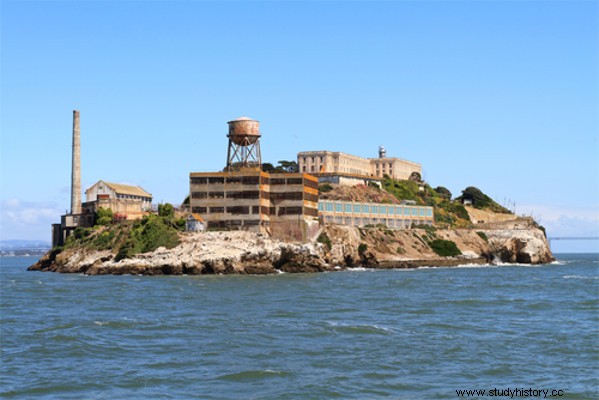
By Rainer Sousa
After the outbreak of the 1929 crisis – an economic shock that hit the United States hard – there was a sudden increase in criminal activities in that country. However, in the San Francisco area there was a small “mound of earth” capable of causing the shivers of many bandits of that time. The tiny island of Alcatraz, between 1934 and 1963, was home to one of the safest prisons on the planet. Figures such as Robert F. Stroud, James “Whitey” Bulger and the legendary mobster Al Capone passed through the place.
In fact, the history of Alcatraz predates the United States of the 1930s. In the 19th century, this island was a region belonging to the still Mexican state of California and was ceded to Julian Workman, with the condition that he built a lighthouse in that area. place. In the same year of the inauguration, in 1846, Mexicans and Americans would enter into conflict to end the hegemonic disputes in that region. With the US victory, Alcatraz would become part of the US expansionist project.
Coincidentally, the newly conquered California would come to gain a much greater importance than imagined during the territorial conflict. In the last months that marked this conflict, the Americans discovered the presence of regions rich in gold in the Californian space. With that, several adventurers and investors would quickly occupy the region in search of the quick financial return provided by the gold exploration.
Due to the expressive economic valorization of the region, the North American authorities used the island of Alcatraz as a strategic point of defense of the territory. In 1853, the construction of a military fort was carried out that would house a military garrison with approximately 200 soldiers. Decades later, with the advancement of war technology, the stored arsenal and the military usefulness of that region would end up losing their usefulness.
In order to avoid creating a completely obsolete space on the island, it was decided, in 1868, to transform the Alcatraz fort into a penitentiary complex. In its first activities, the new penitentiary served as a jail for many indigenous people marginalized by the process of North American expansion. In the early years of the 20th century, it had a significant number of inmates. In a short time, it would be necessary to reform and expand the prison.
In the new project carried out, two large blocks full of cells were built. Taking advantage of the structure left by some smaller buildings that existed between the two blocks, they carried out the construction of a huge wing that connected both blocks, where some Hollywood cinematographic productions used to be shown. According to some legends, the space of the wards hid an ancient underground structure in which prisoners suffered terrible tortures.
After the First World War, the insular prison began to gain greater numbers with the criminal action of smugglers and criminals that would multiply with the creation of Prohibition (1919 – 1933) and the aforementioned outbreak of the 1929 Crisis. the safe and effective penitentiary had become too small for the number of offenders arrested. That's why the government was interested in turning Alcatraz into a federal jail.
Thus, on January 1, 1934, James A. Johnston, the first federal prison administrator, would establish the strict rules that turned Alcatraz into a maximum security prison. At the same time, a disciplinary program was established with the aim of regenerating its prisoners through the use of work and a routine full of restrictions. Among other requirements, prisoners were not supposed to sing, listen to the radio and only bathe twice a week.
Throughout its entire period under the control of the US government, Alcatraz has not had its reputation tarnished by any successful escape. However, some wild plans tried to pierce the walls and the icy waters that surrounded that island. In general, the plans involved a small number of prisoners, and of the 14 recorded escape attempts, only 36 were involved.
In 1963, thanks to the efforts of prosecutor Robert Kennedy, the Alcatraz penitentiary came to an end. To make this possible, Kennedy demonstrated that the cost of maintaining prisoners and staff on that island was about three times greater than any other prison. As a result, its inmates and staff were eventually removed to Marion Penitentiary, Illinois.
After that, an ill-fated project to build an indigenous cultural, ecological and educational center led several natives to occupy the territory. However, the lack of ordination prevented its success. As a result, from 1976 onwards, Alcatraz Island was gradually transformed into historical heritage. Today, despite the opposition of some, the island has become an enigmatic tourist spot that recounts the crimes and repressions of a period of American history.
